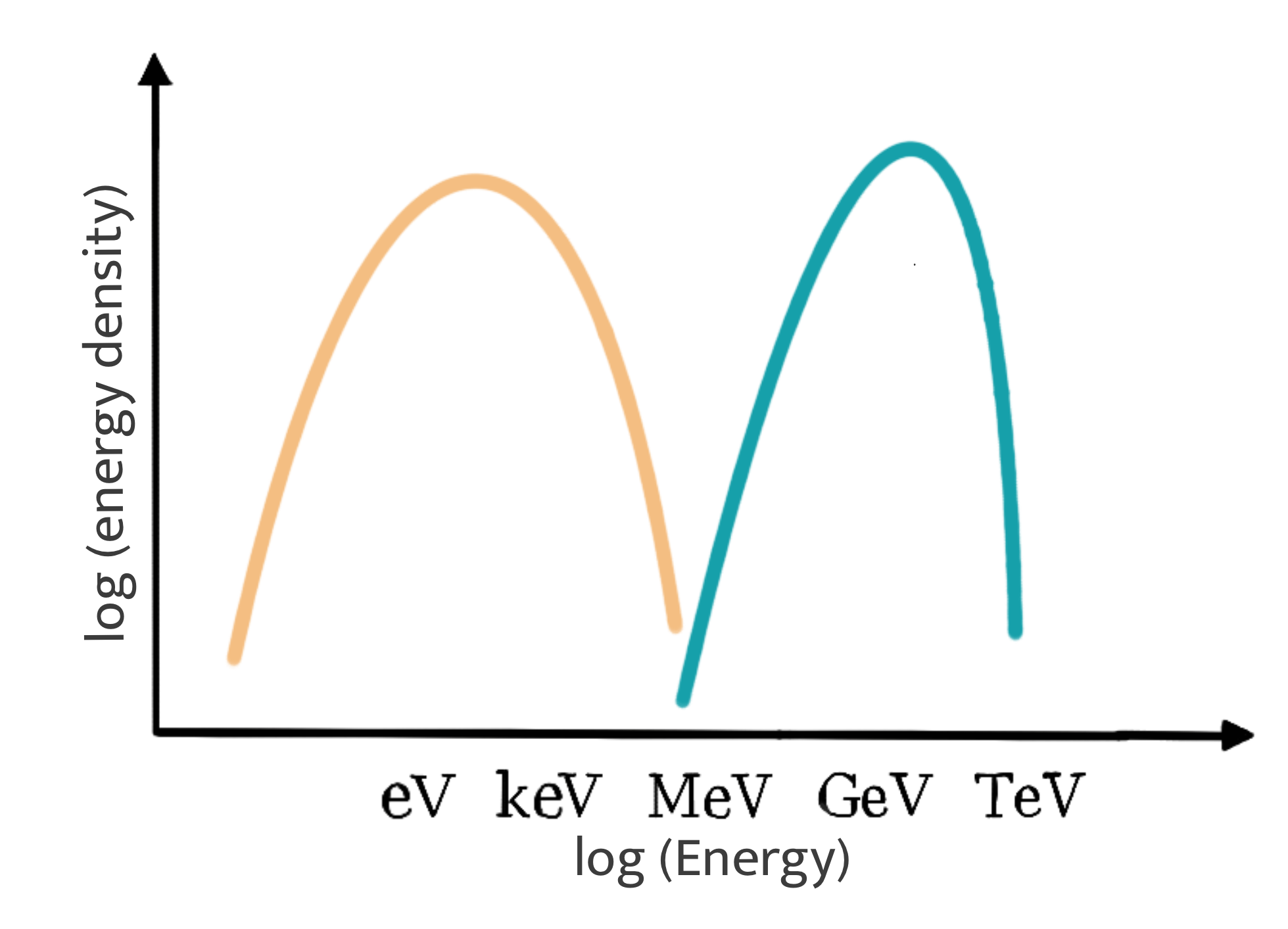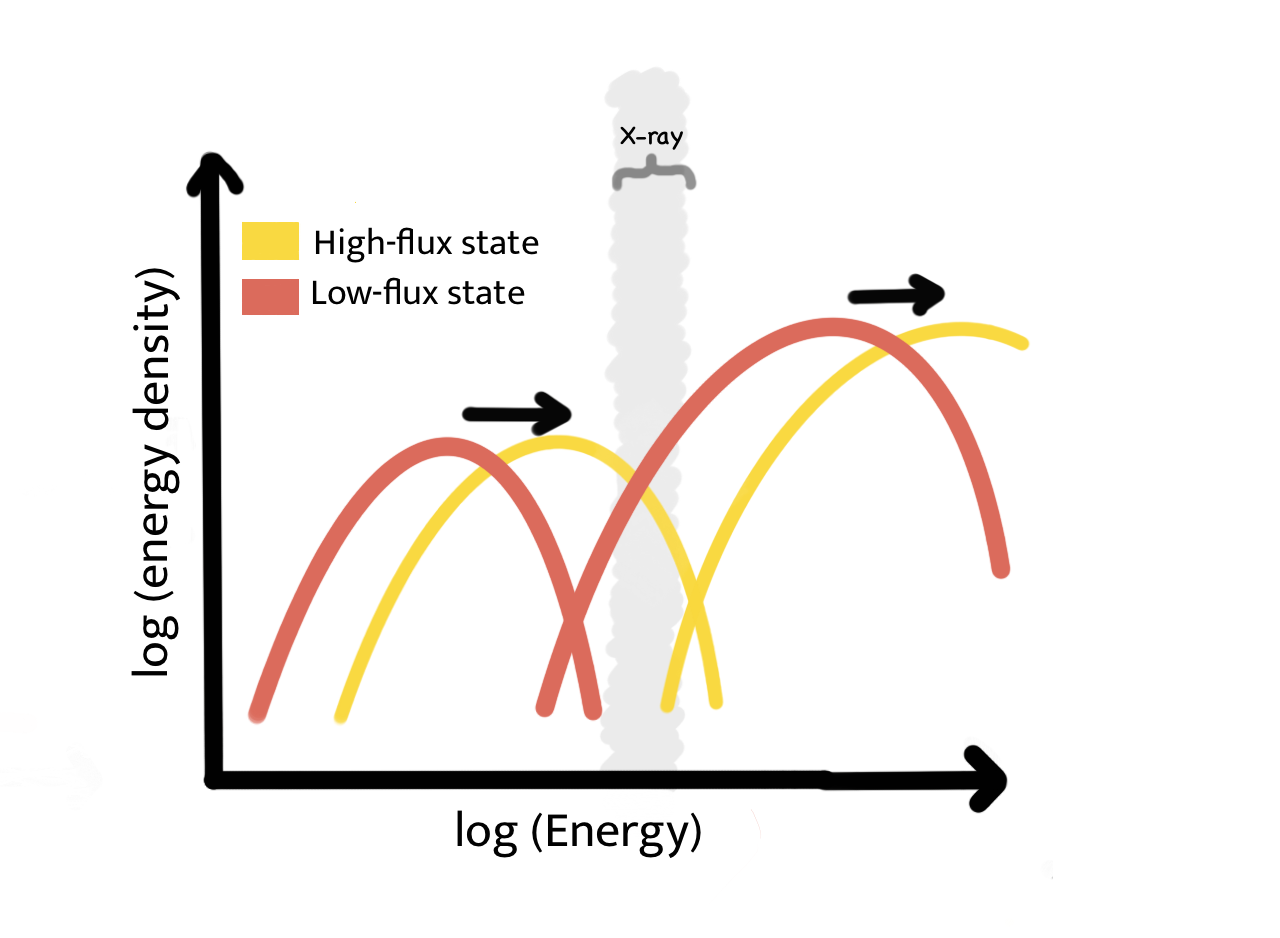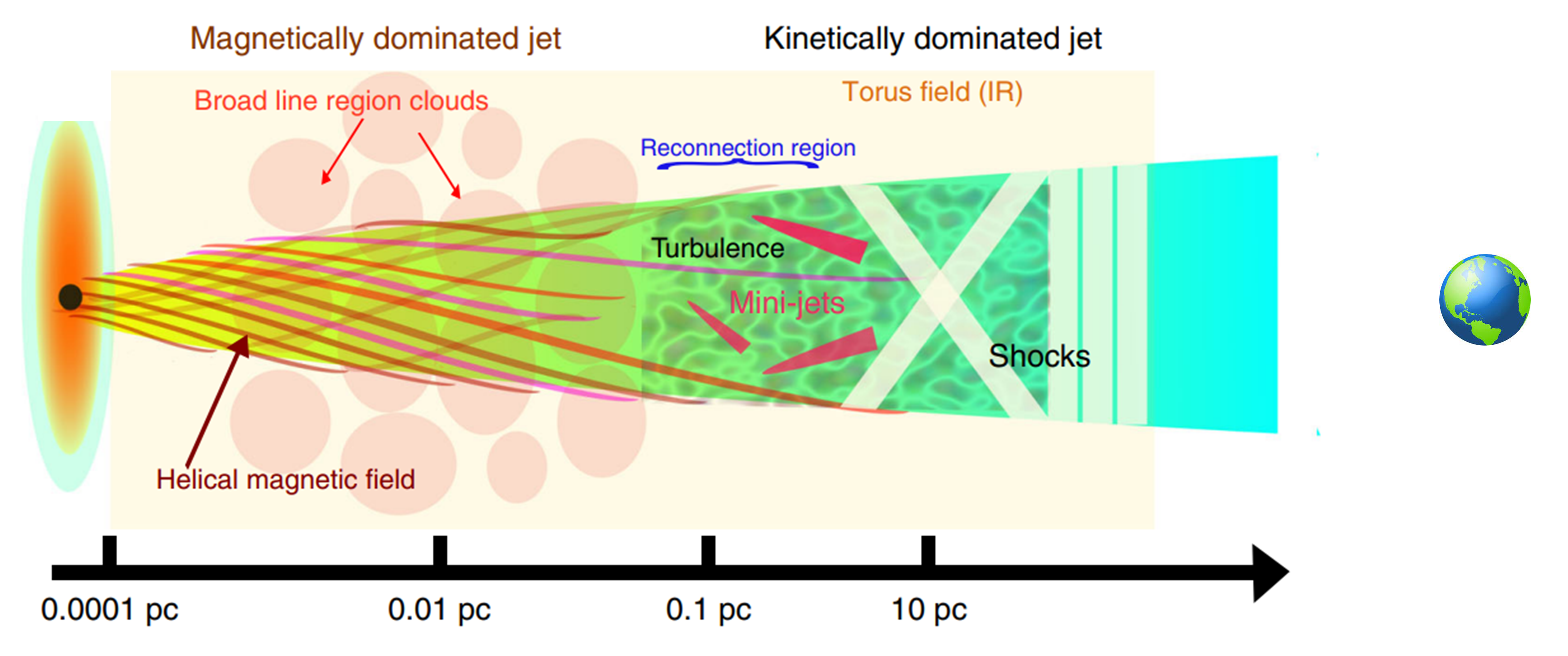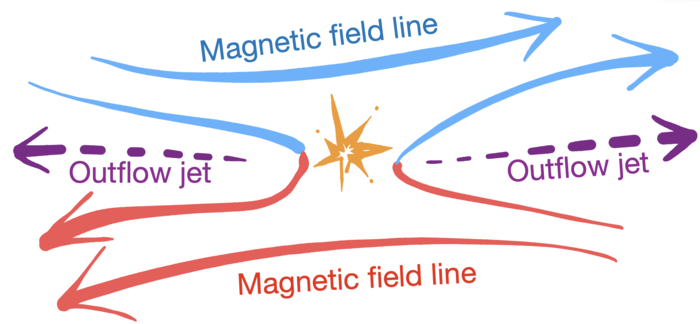Magnetic reconnection as Cosmic lighthouse
The process of production of high energy gamma-ray photons within the jets of blazars remains a mystery, with limited understanding of processes driving the particle accelerations over parsec scales and beyond. The complexity deepens with the detection of photons reaching teraelectronvolt (TeV) energies in some cases. The author explores magnetic reconnection as a mode for particle acceleration in powerful blazar jets.
At the centers of active galaxies, supermassive black holes rapidly accrete surrounding gas through a gas disk known as an accretion disk. This process results in the ejection of plasma jets moving at velocities close to the speed of light, expelling matter up to tens of millions of light-years away from the central black hole [Figure 1].

Figure 1: Artistic illustration of a Black hole, the surrounding accretion disk and the ejected plasma jets. At the singularity, gravitational pull is infinitely strong, enclosed by the event horizon where nothing, not even light, can escape. Surrounding the singularity is the photon sphere, where photons can orbit in stable, circular paths. Gas from the accretion disk spirals inward due to gravity. Some of this material is expelled as relativistic plasma jets extending vast distances into space. Image credits: NASA / JPL-Caltech
Typically, such a structure would appear extended given the dimensions up to which the jets extend; however, the alignment of these objects with respect to the observer on earth makes them look different in size. When viewed head-on, i.e., when the jet is propagating towards the observer, emission from the entire length of the jet is condensed into a “dot” in the night sky, expelling photons from energies as low as radio waves to as high as gamma-rays in the electromagnetic spectrum [Figure 2]. Such point objects in the extragalactic sky are called “Blazar”.
The total energy emitted from blazars results from two primary physical processes, seen as two distinct humps in the spectral energy distribution (SED). [See Figure 2]


Figure 2: (Left) The broadband electromagnetic spectrum encompassing different energies from Radio to gamma rays. (Credits: Brooks/Cole – Thomson Leaning) (Right) The spectrum energy distribution (SED) of Blazar. The two humps highlights two distinct primary processes in relativistic jets of Blazar contributing to observed radiation (1) Synchrotron process (orange) ranging from radio to X-rays (2) Inverse Compton process (Blue) ranging from hard X-ray to gamma-ray energies.
Curious about these processes? Discover more in the ‘journey of particles in the jet’ as you continue reading!
The sources emitting electromagnetic radiation are expected to spread such photons in all directions. Therefore, it is expected that the farther away a source is from us, a lesser amount of photons will reach us making the source appear fainter. Apparently, in blazar, the selective orientation of the jets pointing directly towards the observer on earth, makes the signal appear brighter than if the jet were pointed in any other direction. This effect is called “Doppler boosting”, akin to the amplified sound of a passing siren. This effect makes blazars extremely luminous and variable compared to other objects with similar intrinsic luminosity but unfavourable orientation relative to observer.
The process of production of high energy gamma-ray photons within the jets of these sources still remains a mystery, with limited understanding of processes driving the particle accelerations up to parsec scales and beyond. The complexity deepens with the detection of photons reaching teraelectronvolt (TeV) energies in some cases. In the year 2020, a distant galaxy’s massive core burped out an extraordinary number of high-energy photons toward Earth — twenty times more than expected. Kudos to NASA’s Fermi telescope, our all-sky monitoring eye in gamma rays, it detected this extraordinary flare in part of the sky where lies the known TeV emitter - “Bl lacertae”, about a billion light years away.
Such flares are repeatedly observed in blazars, yet there production mechanism is still largely unknown. In this regard, one needs to explain why Bl lacerate appeared several times brighter than it should be during the year 2020. In this work, we explored the possibility of particle acceleration in relativistic jets of this source to be contributing for its peculiar behaviour.
Journey of a particle through the jet
Imagine being thrown out of a massive black hole. You, a charged particle, have enormous energy thanks to the acceleration from magnetic fields at the base of the jet that was able to throw you out. As you move through the jet, you continue to lose energy through the adiabatic process (a process of losing energy of the particles as the ejected plasma gas expands). Along with that, your precious magnetic field makes you dance around it, resulting in the loss of your energy, part of which leaves you as synchrotron radiation in radio to X-ray energy range.
As you move ahead, dense molecular clouds scatter away photons towards you, causing you to lose energy further and transfer your energy to them through the inverse Compton process. This makes you sufficiently weak; however, you have given birth to a gamma-ray monster and its many siblings that now travel through the cosmos and hit the detectors placed around the Earth.
Photons - the cosmic messengers.
A large number of such gamma-rays, along with their lower-energy siblings, hit multiple detectors on the earth. The number distribution of these photons hitting the detector per unit time provides a view into the particle acceleration processes of the jet. Typically, within the jet, very high speed flows (velocity greater than the speed of sound in that medium), producing shocks, re-energizes the particles to high-energies. However, in the present work led by me along with researchers from India, Italy and Germany, we have found a possibility of another particle acceleration process, called magnetic reconnection (discussed in the last subsection) in fueling the particles in jet. This process involves extracting energy from magnetic fields to energize the plasma particles in the jet. In the massive active galaxy Bl lacertae, after studying the number of photons collected in different energy boxes, it was observed that apparently, the distribution of energy hitting on unit area of detector per sec in different energy boxes is changing based on how many photons are emitted from the Blazar in 100 MeV–300 GeV. In a high-flux state (when large number of photons are emitted from the source) , the X-ray emission is supported by the synchrotron process (the falling part of the first hump; grey patch in Figure 3); however, during a low-flux state (when less number of photons are emitted from the source), the X-ray emission is through the inverse compton (the rising part of the second hump; grey patch in Figure 3). Additionally, the majority of synchrotron photons shift from infrared energies to X-rays (indicated as shift of first hump in Figure 3), indicating a doppler boost, specifically during the high-flux state. Similar shifts were observed for the inverse Compton process (See arrows in Figure 3). Therefore, one can see from this discussion that the ejected photons carry the information of the physical processes occurring in the source in different times, justifying photons as true cosmic messenger.

Figure 3: Sketch of the observed transitioning behaviour observed in Bl lacerate during the low- and high- flux state. The grey patch highlights the transitioning behaviour evident in X-ray energies in low- and high- state. The arrows highlight the shift of peaks of the synchrotron and inverse Compton process as flux transition from low-flux to high-flux.
Such transitional behaviour in blazar challenges existing classification schemes and makes us question if sources’ spectral classification is dependent on its flux levels. Hence, it is extremely important to understand what is resulting in this transition. The flare of the year 2020 had an extremely fast fluctuation, wherein the flux doubled within a few minutes. This constrained the size of the ball of energetic particles to be less than the size of black hole. While shocks are typically efficient particle accelerators in blazars, our analysis indicates an unusually large Doppler factor of 100 is needed to observe emission from such a small particle ball in the jet via shocks. Such large doppler factors is unlikely in blazars.

Figure 4: A representation of site of magnetic reconnection in blazar jet and surrounding jet environment. The broad line region clouds are represented in red circles. Outside the BLR region (at 0.1 pc), the instability grows as a result of which magnetic field are less ordered (turbulent). The turbulent magnetic fields outside the Broad line region provides a site for magnetic reconnection which results in production of mini jets (red cones) through merging of plasmoids into monster plasmoids. Image credits: Shukla and Mannheim (2020)
If not shocks, then what? Magnetic reconnection to the rescue.
Close to the central black hole, within parsec scales, the energy density of molecular clouds (known as the Broad Line Region or BLR) peaks. As the jet breaches the outer edge of BLR, magnetic field lines undergo twisting and turning due to turbulence induced by instabilities [Figure. 4]. Within this dynamic environment, oppositely aligned magnetic lines break and reconnect. This snapping of magnetic lines forces out magnetized plasma at high velocities. The magnetic energy generated is then transferred to plasma balls by a tension force, much like the force that propels objects from slingshots. These energized plasma balls, referred to as plasmoids, gradually merge together into larger structures, eventually forming monster plasmoids.

Figure 5: Magnetic reconnection: Schematic of breaking, rejoining of oppositively aligned magnetic field line. Image credits: Yi-Hsin Liu/Dartmouth College
These relativistic plasma structures, akin to mini-jets within the main jet, move randomly at the edge of BLR (Figure 4). When aligned towards the observer at earth, the emission is doppler boosted, along with simultaneous increase of flux due to specific alignment of mini-jet. Conversely, when the mini jet deviates from the observer’s line of sight, flux levels diminish, accompanied by a de-boosting of energy.
This selective alignment, like a lighthouse within a jet, reveals the intricacies of flux enhancement along with the transitioning behaviour in blazar.
Original paper: Flaring activity from magnetic reconnection in BL Lacertae
First Author: Sushmita Agarwal
Co-authors: Biswajit Banerjee, Amit Shukla, Jayashree Roy, Sriyasriti Acharya, Bhargav Vaidya, Varsha R. Chitnis, Sarah M Wagner, Karl Mannheim, Marica Branchesi
First author’s Institution: Indian Institute of Technology Indore, India
